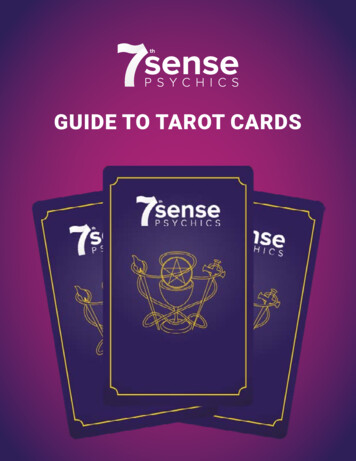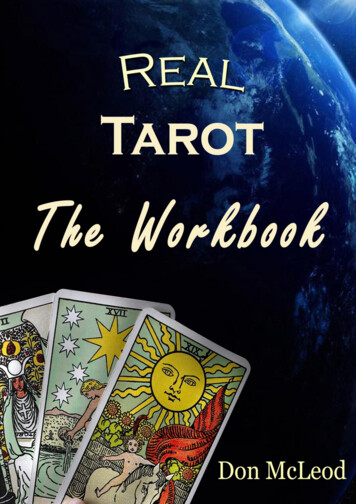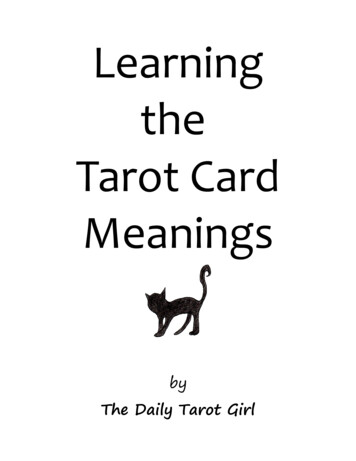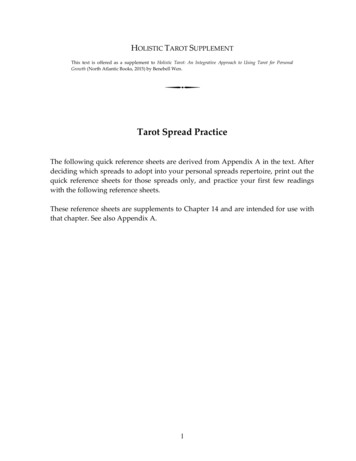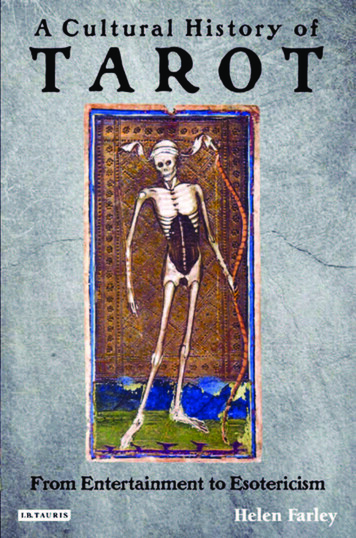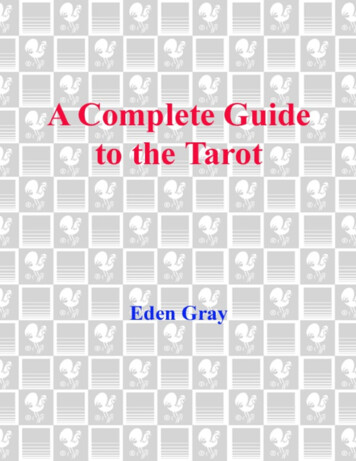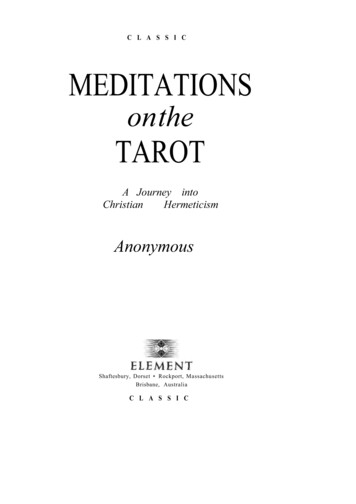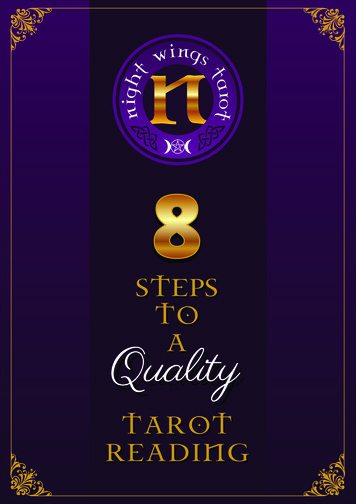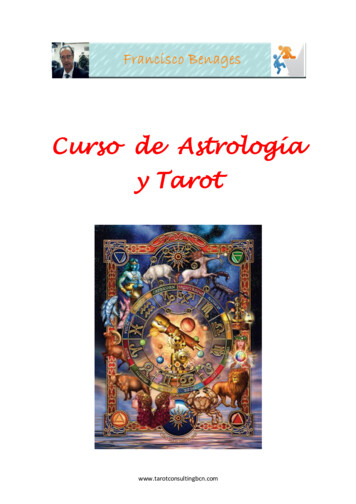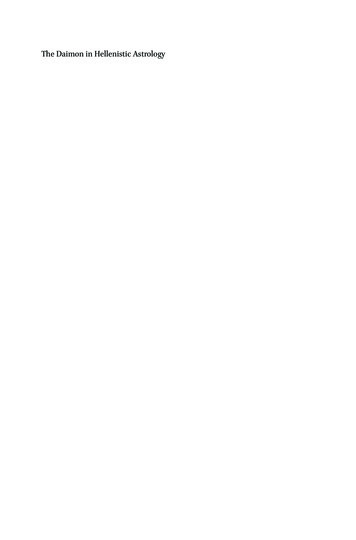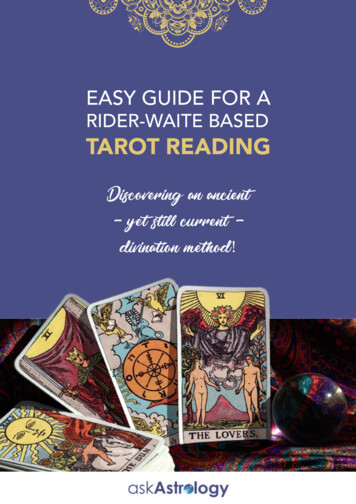
Transcription
Tarot as a Counseling Language:Core Meanings of the CardsbyBradford Hatcher
2020 Bradford HatcherISBN: 978-0-9824191-3-7Download at: https://www.hermetica.info/Tarot.htmor: https://www.hermetica.info/Tarot.pdfCover Photo Credit: Excalibur, by Erulian (Karel Hamm)
Table of ContentsPDF PageIntroduction4Tarot as a Language22Historical Notes and Timeline32Correspondences39Component Ideas in the Minor 61The Symbols of Western Astrology331Bibliography, Recommended Reading355
IntroductionThis book was written for a narrower range of readers than the much broader set ofTarot aficionados. As the title suggests, this will attempt to re-envision the study in away that is specifically useful in counseling, and to better understand the coremeanings of the cards in these terms. Since effective counseling assumes somethingakin to agency or self-directed behavior, the aspects of Tarot that concern fortunetelling or predicting the future will be dropped from this study. But the goal here ismore ambitious than that. The Tarot, as a system of symbols or a symbolic language,has something to offer to an even more rigorous skeptical inquiry, almost in ananthropological sense, and certainly in a psychological one. It is a cognitive tool kit,and descriptive of an attitudinal skill set. There is little in print that is dedicated to suchan approach. The intended reader here is an intelligent skeptic, with an unabridged setof critical thinking skills. This means that there will also be other casualties in thisanalysis, such as ‘new age’ metaphysics and fanciful misinterpretations of Jungianpsychology. Number symbolism will remain, in some detail, but numerology will bedismissed. Religious symbolism and iconography, where not completely gratuitous,might be treated as symbolic of psychological processes rather than analogs ofmetaphysical realities. However, it is sincerely hoped that enough valuable informationabout the cards will be presented here that even readers pursuing more conventionalapproaches, and especially those writing their own books on the subject, can still comeaway from this thinking that their time here was well spent. One should not, however,expect this to be an easy read, and one might suspect the author of taking some delightin sending the reader to the dictionary. This is for the education, not entertainment,barring the occasional bit of dark humor.Such a purging of the field, done for the sake of readers with more rigorousintellectual standards, may prove unpalatable to many, but this book is not written formarket, or to profit from the gullible. Ergo, you may have noticed already that thisbook will not try to spare the sensitive feelings of the “true believer.” This is atechnical term for someone who has personally identified with a belief or set of beliefs,such that any challenge to these beliefs, or mockery thereof, must be taken as apersonal or existential threat, and defended against at all costs, even at the cost offoregoing any new input. There are a lot of these thin-skinned people studying Tarot.There are also a lot of relativists, who believe that all perspectives are valid. Manycannot even be told that two plus two does not equal five. It may be just as well thatthese people set this book down now. Even at the expense of sounding arrogant orpatronizing, I don’t intend to hesitate to call something wrong. As an Aspie, tact is nota big priority. As a classical Cynic, I like my parrhesia. And as a Nietzschean, I likemy swordplay. Having waded through more than 150 books in preparing this text, I'veseen far too much nonsense, and I feel no duty to perpetuate any of that. I want to seethe Tarot grow in respectability. I don’t want new age cooties. I feel an obligation tothe future of Tarot as an evolving, open-source culture.The Tarot presented here is simply a system of symbols that makes up an interestinglanguage that’s useful in talking about attitudes and mental states. The approach forour purposes here is narrower than usual in a couple of ways, and sets aside a numberof associations and structural dimensions that might be thought peripheral, extraneousor irrelevant. This might be done with a dismissive attitude. Many of these set-asideswill have allies and champions who regard them as absolutely essential. Among theoffended may be strict adherents to the Golden Dawn approach, to which this workadheres with at least some degree of fidelity. This is because it is asserted here that this
system contains errors: not a lot of errors, but a few in important places. It may well beasked where the qualifications are to make such corrections, or where the ancientauthority lies. But this is merely a reluctance on the part of the author to continue sucherrors under the watchful eyes of skeptics, who are often armed with logic, and evencommon sense. It is important to understand that actions taken here are for thepurposes stated here, and there is no way to stop anybody who wants to add anydeletions back into their personal system.It is also important to note that there will be ideas presented here, and mentioned inmatter-of-fact tones, that sound suspiciously like mystical or even religiousexperiences. But skeptics ought not concern themselves overmuch, as theseexperiences are simply part of the inherited human lebenswelt and even good scientistscan be subject to having them. No theories of objective reality will be constructedthereon. Wherever the word psychic is used, it refers to the subjective mental worldand not to the paranormal. No mention will been made of how or whether the cardswork. This will be left to the readers or their querents. It would be nice to approach thissubject with the same intellectual rigor that is at last being seen in studies of Tarothistory, at least as far as historical evidence allows, but standards of scholarship mustnecessarily be different for history than for meanings. Rigorous standards are simplynot as applicable when the exercise is primarily creative. Perhaps the best that can behoped for is the honest voice of the child who calls out in mid-parade: “Why is theEmperor naked?”Mary Greer identifies 21 reading styles or ways to read Tarot cards (21 Ways, p.271). Many of these are outside the purview of this book. Only a few of theseapproaches will fit the language model that is being explored here. Others remainimportant, however, as vehicles for subjective experience. In a reading, we want thecards to take us on journeys, to take us as far as necessary from any idea of consensual,central, or core meanings to get the information that we are looking for. In culturalstudies and depth psychology we want to explore the symbolisms and mythologies inall of the rich detail that can be uncovered or extrapolated. The images of the cards,particularly those of the much older images of the Trumps, offer us enriching travelsthrough the imagination. In magick, we want to invoke these cards and their meaningsas entities and explore them from the inside as experiences, out to the edges of wherethey can take us and even beyond the known and expected. In pathworking, orimagining ourselves transitioning between symbols on a diagram such as the Tree ofLife, we can further enrich, detail and, texture our metaphors. In meditation, we canmake use of the cards as Tattwas or Kasinas. In spellworking, analogs of cards may beburned, immersed, altered or buried as charms. If superstitiously inclined, we can usethem as talismans and amulets. We may bifurcate the methods by contrasting magickaland intuitive with rational and analytic. One of the primary distinctions in approachesconcerns whether the meanings of the cards are expanding or contracting, diversifyingor narrowing. When we are simply allowing the cards to take us places, by letting go ofthe mental reins, letting the symbols speak, freeing the imagination, and readingintuitively or pathworking, the potential meanings multiply. But even in the moreexpansive modes, consensually affirmed centers of meaning will offer us a knownplace from which to begin the wider journey.Some approaches will require hyperbolic exaggeration, going over the top and getting carried away, all full of emotion and ecstasy. Magick seeks attainments, andmysticism, first-hand experiences. In spellworking, there is a role for hyperbole inraising magical energy through states of excitement. Meister Eckhart describes theinvocation process simply: “When the Soul wants to experience something she throwsout an image in front of her and then steps into it.” Of course the common error
subsequent to doing this is in reifying the experience, thinking that first-handexperience is identical with objective knowledge, that the discoveries made inexperience are in fact dimensions of reality. We mistake our interpretations for facts.And as humans, we tend to find exactly what we are predisposed to find by ourexpectations and insecurities. But an idea common to both the therapeutic and theintuitive approaches is that we can invoke our way into different states of mind usingdifferent symbols, images, or cards, and into a variety of attitudes, as though this arraywere some kind of cognitive tool kit or wardrobe. This aspect of the approach here isnot entirely analytic or rational, although it does call for a rationally pragmatic notionof truth to assess the effect of the process. In counseling, this effect is often a change inmaladaptive behavior. It’s about what you do with the cards, not what they tell you todo, or what they do to you, or what they say will be done unto you. A word of caution,though, on spellcraft and the cards: each card has a wide range of meanings, includingthose seen by readers who read reversals. If you are casting a spell with a card, be sureto grasp the wider range of meanings. Magick loves irony, and irony will find you. Becareful what you wish for.In ceremonial magick there is a distinction between evocation and invocation. Inboth cases, you’re calling some force. In evocation, that something stays outside ofyou, and is confined to some area like a triangle, while you are protected by a magiccircle. In invocation, you bring the force inside you while you both remain within thecircle. Tarot cards should be understood in both of these ways as well. A card can besomething objective and outside of you, maybe doing something to you, or offering aproblem to be solved, or it can be internalized, as a personal experience or a skill to beused, or an attitude to adopt. Or, in the case of Pip cards, a third option might be thatyou internalize the number while the suit becomes your object or tool.We will assume that you are not a never-ever level of beginner to the Tarot and thatyou already know at least few basic things about the subject. If you are a novice, someintroductory reading is recommended first. This need not be book length. It can evenbe something as basic as the main Wikipedia article. There are also a number of otherlinks to be found at my Hermetica site. Try browsing the first section for introductorymaterial. Before going too far beyond this Introduction, there is also a 35-page pdfSupplement to this work. This contains a lot of excerpted material that is specific toworking with the symbolism of the Yijing o r Book of Changes, but this symbolicsystem also has a lot in common with Tarot and most of what is laid out here is alsorelevant to understanding the cards. You may, without great consequence, skip or failto understand any of the portions that use the more technical Yijing terminology.As for a general note on learning Tarot, we should note that beginner's books are abad idea, given the way people learn and unlearn. People have a tendency to learn andaccept things without a complete understanding of the implications of what it is they’relearning. But once they believe the first thing they have read, they must then disbelievethe next half-dozen things that contradict it. This is in part called the sunk cost fallacy,and in part the fact that unlearning later is considerably more effort than learning in thefirst place, and there’s also something of self-criticism in there that says they werefoolish to allow an error to come live in their heads. Now the error has a long-termlease. These are the main reasons to build a basic knowledge of Tarot with the bestmaterials we can find, and avoid beginners’ books. We should challenge ourselves todo things well from the start, since we will be living with the results and they will beproportionate in quality to the effort invested. We don't want to build a real house on aPlay Dough foundation. Start off with shortcuts and books for the lazy and you buildon a crap foundation. Finally, no matter how creative you may want to get eventually,a solid foundation means taking fairly conservative approaches at first. We should
avoid anything too idiosyncratic. There’s nothing wrong with artists expressingthemselves and going nuts with the Tarot's potential to inspire. But Tarot is a language,and you want to begin with a dialect that most people understand, not one known toonly a few, unless you want to live in some distant province.Prediction and DivinationOne of the more radical changes in a counseling approach is the move away fromfortune-telling or predicting the future, and avoiding attempts to explain how the futuremight be known, or what mysterious forces are translated into the mechanics ofdrawing the cards. The assumption is that if counseling is to be effective, presentdirections in life need to change. Free will, or agency, or self-directed behavior, isbrought into play. This also throws up a challenge to conventional wisdom bysuggesting that no card should be regarded as inherently good or bad. There aren’t anynecessarily ‘positive’ or ‘negative’ outcomes or predictions, unless these words areunderstood without attached value judgments. Each card represents a lesson
This book was written for a narrower range of readers than the much broader set of Tarot aficionados. As the title suggests, this will attempt to re-envision the study in a way that is specifically useful in counseling, and to better understand the core meanings of the cards in these terms. Since effective counseling assumes something
